Angus Zou (鄒斯傑) seems very comfortable with interviews as he leans forward effortlessly in the off-burgundy leather chair he’s reclining in to hand me a name card.
The card is simple and black with the name of the bar — Alchemy — etched on it, and the address printed in gold. Below the address is the word “reservations” followed by a number to dial.
Donning a maroon dress shirt and a form-fitting gray vintage vest, Zou says the reservation system is to follow, as close as possible, the proper protocol of 1920s-era speakeasy bars in the US. When he opened Alchemy — which is arguably Taiwan’s first speakeasy-type establishment — in 2012 after years of working at big-name bars such as Barcode and Marquee, Zou wanted to keep it as low-key as possible. In the three years since, nearly every Taiwan-centered blog has touted this “hidden haunt” and Zou’s incredible mixology skills. He doesn’t like crowds, but he has over 1,000 followers on Facebook. No wonder he’s a little jaded about interviews.
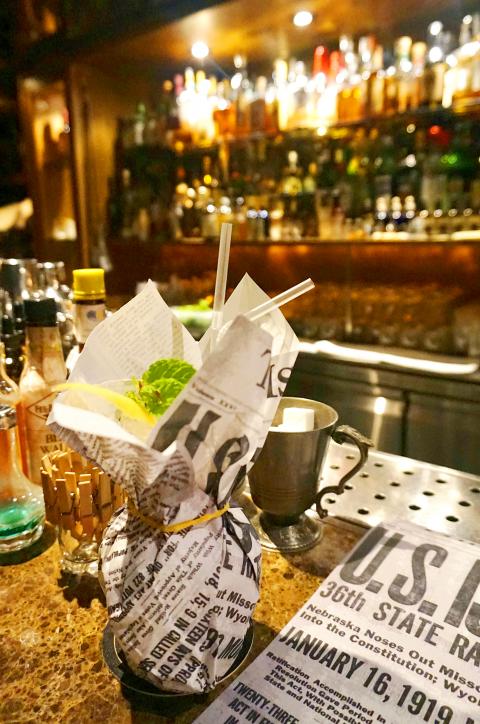
Photo: Dana Ter, Taipei Times
Warning: Excessive consumption of alcohol can damage your health.
I inquire about the table Zou placed the name card on and he says it’s vintage marble from Italy, almost a hundred years old. In fact, most of the sofas and bar top chairs are vintage, creating a vibe more akin to one of the many snug, underground themed bars in New York’s Lower East Side or London’s Soho-Chinatown area. It’s hard to imagine that we’re actually on the second floor of Marquee, right opposite of the Taipei 101 and surrounded by bars and clubs that pack hundreds of patrons.
“The scene here is that people want to go out and have fun — and there’s nothing wrong with that,” Zou says with obvious disdain in his voice.
“But the people who are interested in speakeasies — these are the types who know how to appreciate a good drink with good service and ambiance,” he adds.
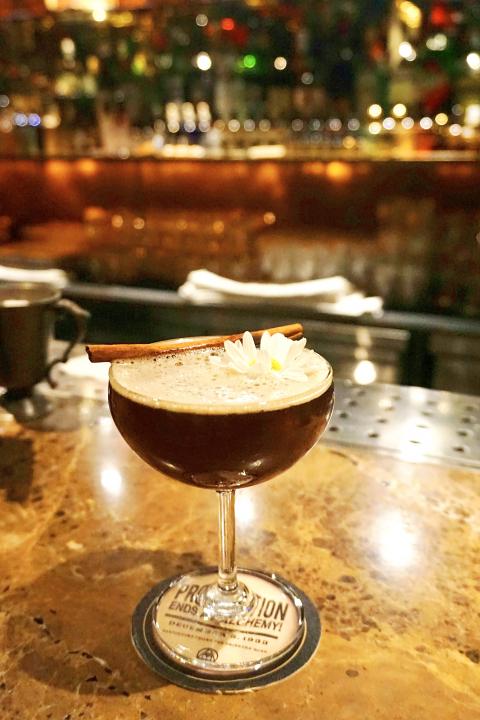
Photo: Dana Ter, Taipei Times
Warning: Excessive consumption of alcohol can damage your health.
Customers can either order from Alchemy’s extensive menu which includes drinks with enticing-sounding names such as Bank of Mafia (NT$450) or the Swing Jazz (NT$450). They can also ask the bartender to make a cocktail for them based on the flavors they like.
The bar — a narrow counter to the side of the room with a marble top — stocks an impressive amount of whiskeys and bitters collected from around the world, as well as a fresh fruit display and a flower vase where bartenders sometimes pluck from to add garnishing to drinks. Service is attentive and top-notch and there’s no jostling needed.
The idea behind Alchemy came to Zou after his disillusionment with Taipei’s many massive-scale bars drove him to take a break and travel the world. He jetted to London, Paris, Tokyo and New York where he attended bartending events and made countless toasts at sake bars, vintage watering holes and exclusive members-only clubs such as London’s Milk & Honey.
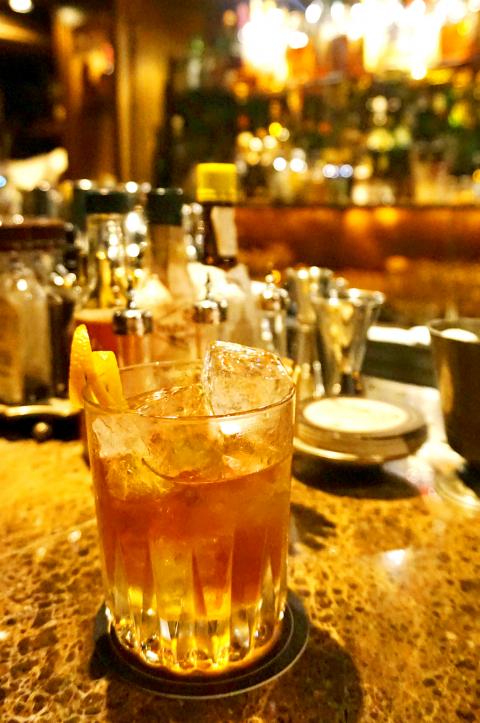
Photo: Dana Ter, Taipei Times
Warning: Excessive consumption of alcohol can damage your health.
Zou lets his blase demeanor slip a bit when he talks about London.
“Walking through Chinatown, there are people who just want to get drunk and start fights on the streets, but there are also so many other choices, oftentimes hidden in little basements,” he tells me.
It was something he saw as lacking in Taipei’s drinking scene back then: choices. Soon, it became his dream to open a quiet, somewhat exclusive bar for people who prefer to escape the crowds. Like “a gentlemen’s club,” he says, but one where ladies are allowed in, of course.

Photo: Dana Ter, Taipei Times
Warning: Excessive consumption of alcohol can damage your health.
“Access to alcohol in Taiwan is too easy,” Zou adds, referring to cheap beer that can be bought from 7-Eleven and other convenience stores. “It makes it such that people can drink all day everyday and not really appreciate it.”
Three years later, and Alchemy has somewhat changed the drinking scene by catering to a growing crop of savvy, well-traveled tipplers who enjoy a good Old Fashioned. Since their opening, numerous speakeasy-type bars have been popping up, Ounce being another popular one.
The establishment’s success can almost certainly be attributed to Zou’s no-nonsense attitude and doing what he does best — that is, being different. The bar barely holds promotional events and refuses to give special offers for holidays such as Christmas — “it’s too commercial, too much of an excuse to party,” Zou says.
They do, however, host live jazz every Wednesday and Thursday nights. As a result, Alchemy’s existence has spread through word of mouth, just as during the Prohibition era.
Seeing my face drop when he mentions they don’t celebrate Christmas at the speakeasy, Zou says he’ll make me a Christmas drink — “something warm and familiar,” he says, sizing up my personality.
Zou returns behind the bar and whips out a London Porter and some cinnamon powder, two of my favorite flavors. Already, I feel special.
Taipei is a city that has positioned itself as being cheap and fast, but the revolution for craft drinks is taking wind and alcohol aficionados are thirsty for more. Drinking Taipei is a monthly column devoted to spotlighting chic, conceptual bars that aren’t your typical watering hole.
TOP PICKS
Dana’s Cinnamon Christmas Cocktail
(built to spec)
My specially-made drink consists of a dark, chocolatey London Porter mixed with rum, ginger juice and pandan syrup with dabbles of cinnamon powder and Christmas bitters. Zou asked me to come up with a name so I dub it Dana’s Cinnamon Christmas Cocktail. The drink, Zou says, is a spin off the traditional eggnog. The white flower garnishing plucked from a bouquet on the bar top evokes the gentle touch of a snowflake, while the cinnamon gives it a hint of Christmas. Or as Zou says, “throw anything with cinnamon in it, and it becomes reminiscent of Christmas.” Either way, the cocktail tastes like everything I like — mini cinnamon toast, eggnog and dark European porters — without me ever telling Zou my preferences. The cocktail pairs well with caramel and nutmeg-based desserts. — NT$450
Beginning of Prohibition
A blend of Maraschino (Italian cherry liqueur), Angostura 1919 rum (which, coincidentally, is the year that Prohibition was introduced in the US), lime juice, syrup and bitters, this signature Alchemy drink boasts a strong, stingy cherry taste that doesn’t sit well with non-alcoholics. The drink is served in a bottle wrapped with “newspaper” dated back to Jan. 16, 1919 — the date the US went dry. The newspaper bag is also a nod to the practice of hiding booze inside brown paper bags in the US, as it is still illegal in most of the country to be seen carrying alcohol in public. The coaster reads: “Prohibition Ends At Alchemy! Dec. 5, 1933” — the date the 18th Amendment instituting Prohibition was repealed. Zou will explain the history more in-depth to customers who are interested, if not, “well, don’t waste my time,” he says. — NT$450
Old Fashioned
Said to be the first cocktail to be invented in the late 19th century, the Old Fashioned is a safe bet and simple enough to make. It consists of sugar, water, bitters and spirits (in this case, Bourbon). In the series Mad Men it was well-known as Don Draper’s favorite drink. Served in a crystal tumbler and topped with an orange peel garnishing, the Old Fashioned is punchy, spicy and also immensely strong. It’s one of Zou’s favorite cocktails. — NT$450
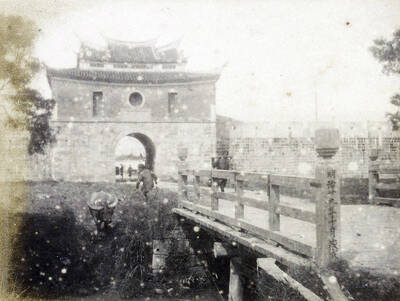
June 9 to June 15 A photo of two men riding trendy high-wheel Penny-Farthing bicycles past a Qing Dynasty gate aptly captures the essence of Taipei in 1897 — a newly colonized city on the cusp of great change. The Japanese began making significant modifications to the cityscape in 1899, tearing down Qing-era structures, widening boulevards and installing Western-style infrastructure and buildings. The photographer, Minosuke Imamura, only spent a year in Taiwan as a cartographer for the governor-general’s office, but he left behind a treasure trove of 130 images showing life at the onset of Japanese rule, spanning July 1897 to
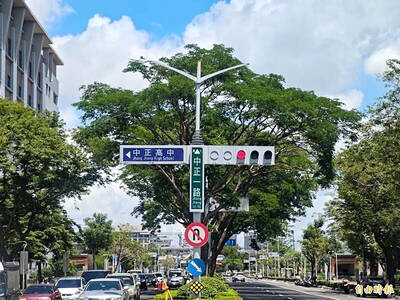
One of the most important gripes that Taiwanese have about the Democratic Progressive Party (DPP) is that it has failed to deliver concretely on higher wages, housing prices and other bread-and-butter issues. The parallel complaint is that the DPP cares only about glamor issues, such as removing markers of Chinese Nationalist Party (KMT) colonialism by renaming them, or what the KMT codes as “de-Sinification.” Once again, as a critical election looms, the DPP is presenting evidence for that charge. The KMT was quick to jump on the recent proposal of the Ministry of the Interior (MOI) to rename roads that symbolize

On the evening of June 1, Control Yuan Secretary-General Lee Chun-yi (李俊俋) apologized and resigned in disgrace. His crime was instructing his driver to use a Control Yuan vehicle to transport his dog to a pet grooming salon. The Control Yuan is the government branch that investigates, audits and impeaches government officials for, among other things, misuse of government funds, so his misuse of a government vehicle was highly inappropriate. If this story were told to anyone living in the golden era of swaggering gangsters, flashy nouveau riche businessmen, and corrupt “black gold” politics of the 1980s and 1990s, they would have laughed.
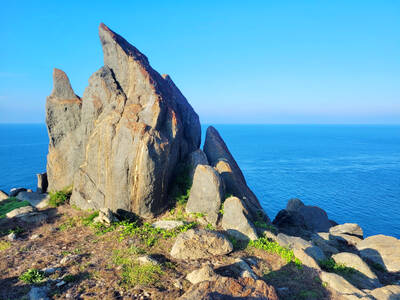
It was just before 6am on a sunny November morning and I could hardly contain my excitement as I arrived at the wharf where I would catch the boat to one of Penghu’s most difficult-to-access islands, a trip that had been on my list for nearly a decade. Little did I know, my dream would soon be crushed. Unsure about which boat was heading to Huayu (花嶼), I found someone who appeared to be a local and asked if this was the right place to wait. “Oh, the boat to Huayu’s been canceled today,” she told me. I couldn’t believe my ears. Surely,